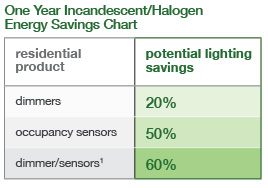2. All Lutron Dimmers Save Energy.
Every dimmer automatically saves 4-9% in electricity—even at the highest lighting levels—over a standard on-off switch. When users choose to dim their lights, even more electricity is saved. Quite simply, the more you dim, the more you save. A standard light switch only saves electricity in the “off” position. Lutron dimmers and controls save energy 24-7.
3. All Light Sources Use Less Energy When Dimmed.
While incandescent lights are typically associated with dimming, all lighting sources, including halogen, CFLs, and, LED bulbs, can be dimmed. For example, a halogen light source dimmed 35% reduces energy use by 28%. On average, dimming an incandescent or halogen light will reduce energy use by about 20%.
4. Dimming Saves Energy and the Environment While Enriching Your Life.
While there are many ways to reduce energy use, most involve sacrificing something. Few actually enrich the quality of living and working environments like dimmers. Dimmers and other lighting controls allow individuals to adjust light levels for specific entertainment options, enhance ambiance, set a mood, and take advantage of daylight to reduce energy use.
5. Lutron solutions can contribute to 46 of the 110 possible points in LEED NC v4.
Because of their energy saving benefits and contributions toward minimizing environmental impact, Lutron lighting and shading controls can contribute significantly to attaining Leadership in Energy and Environmental Design (LEED) building certification for new construction. Lutron can help builders attain credit in several LEED categories: Energy & Atmosphere, Material & Resources, Indoor Environmental Quality, and Innovative Design.
6. Using Dimmers Saves Money.

Reference: Heschong Mahone Group. 1999. Lighting Efficiency Technology Report. Prepared for the California Energy Commission
7. Shading Solutions are also Energy Efficient.
Shading systems save energy by harvesting daylight and reducing the load on HVAC systems, making any project more eco-friendly. Shading can also be made from eco-friendly materials. Sustainable materials from Lutron are either PVC-free or are 100% recycled. This has allowed some fabrics to receive certification from third-party organizations such as GREENGUARD and Oeko-Tex.
8. Each year, installed Lutron products save nearly 10 billion kWh of energy. This is equivalent to:
- 7 million metric tons of CO2 equivalents2.
- Taking 1.5 Million cars off the road2.
- Avoiding consumption of 16 million barrels of oil2.
9. Lutron Systems can Automatically Save Money and Energy.
Automated systems like daylight and occupancy sensors and the HomeWorks astronomic timeclock can turn on lights according to changes in light or the time of day. Without any input from the user, Lutron systems can reduce energy costs and usage.
10. All Lutron Dimmers Extend Bulb Life.
Dimmers reduce power to the lighting source or bulb, so they save energy and can extend bulb life. Incandescent and halogen bulbs last up to 20 times longer when used with a dimmer, increasing the money saved.LED bulbs run cooler when dimmed which can also extend bulb life.
1Estimated lighting savings based on a power reduction of 20% (dimmer) and a 50% reduction is hours of use (sensor).
2Estimated savings based on Lutron sales; 296kWh annual energy use for residential circuits (a); 2,492kWh annual energy use for commercial circuits (b); 20% savings from dimming (c); a U.S. average electricity rate of $0.11 per kWh (d); estimated greenhouse gas equivalency (e); and the average generating capacity of a coal power plant (d). - Computed from energy usage by room type (Source: Navigant. 2002. U.S. Lighting Market Characterization.) and surveys of installed room types (Lutron commissioned Ipsos surveys).
- Computed from 712W per circuit (Lutron project data.) and 3500 annual hours.
- Lighting Efficiency Technology Report: Volume I. 1999. California Energy Commission.
- Energy Information Administration (EIA)
- U.S. annual non-base load CO2 output emission rate, year 2007 data U.S. Environmental Protection Agency, Washington, DC.